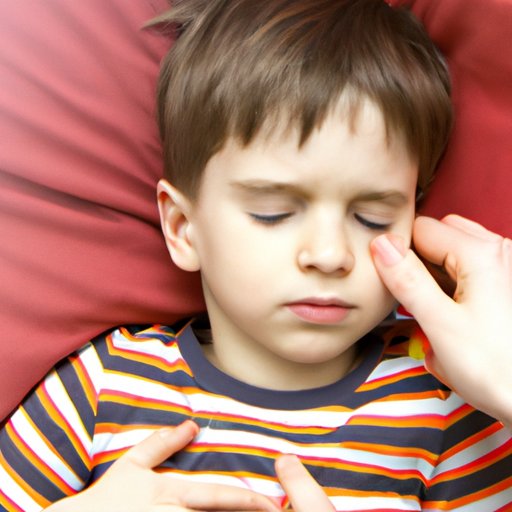
Introduction
Croup is a respiratory condition that often affects children, causing inflammation to the airways and difficulty breathing. While it is a common illness, it can be dangerous, and it is important to understand the causes, symptoms, and treatments associated with it to provide appropriate care and prevent complications. In this article, we will explore the causes, symptoms, and treatments of croup while providing valuable information on how to cope with the illness.
Understanding the Causes of Croup: From Viruses to Allergies
Croup can be caused by a variety of factors, including viruses such as parainfluenza, allergies, and exposure to irritants. These factors cause inflammation to the larynx, trachea, and bronchi, leading to a narrowing of the airways and difficulty breathing.
Viruses are the most common cause of croup in children. Parainfluenza virus is the most common culprit, accounting for up to 75% of all cases of croup. However, other viruses such as respiratory syncytial virus (RSV) and influenza can also cause croup. Allergies and exposure to irritants, such as smoke or pollution, can also cause inflammation to the airways and trigger croup symptoms.
What Parents Need to Know About Croup in Children
Croup is most common in children, with those between six months and three years old being most susceptible to the illness. Children with weakened immune systems or underlying respiratory conditions like asthma are also at greater risk of developing croup.
The symptoms of croup in children can vary from mild to severe and typically include a tight or barking cough, hoarseness, difficulty breathing, and a high-pitched sound when inhaling (known as stridor). Parents should look out for these symptoms, especially if the child has a fever or appears to be in distress.
To protect children from croup, it is important to practice good hygiene, such as washing hands frequently and avoiding close contact with individuals who are sick. Parents can also speak to their healthcare provider to determine if their child should receive a flu vaccine or talk to their child’s physician about other preventative measures.
Exploring the Symptoms of Croup and When to Seek Medical Help
As previously mentioned, the symptoms of croup can vary and may include a barking cough, hoarseness, and difficulty breathing. To distinguish croup from other respiratory illnesses, it is important to look for a high-pitched sound when inhaling (known as stridor), which is a telltale sign of the condition.
While mild cases of croup can be treated at home with rest and appropriate relief measures, parents should seek medical help if a child is struggling to breathe, has blue lips or fingers, or appears very sick. In most cases, children with moderate to severe croup will need to be evaluated by a healthcare provider and may require hospitalization or treatment with medication such as corticosteroids or epinephrine.

Natural Home Remedies for Relieving the Symptoms of Croup
While over-the-counter cough and cold medication is not recommended for treating croup, there are several natural remedies that may help relieve symptoms. One popular remedy is steam therapy, which involves taking the child into a bathroom with a hot shower running to increase the humidity in the air and soothe inflamed airways. Another remedy is providing cool, moist air from a humidifier or by taking the child outside on a cool night. It is important to note that while these remedies may provide comfort, they are not a substitute for medical treatment. Parents should always consult with their healthcare provider before trying any new remedies.
Diagnosing Croup: How Doctors Identify the Condition in Children
Healthcare providers typically diagnose croup by conducting a physical exam and evaluating the child’s symptoms. The doctor may listen to the child’s breathing and check their oxygen levels. In some cases, an x-ray or other imaging tests may be recommended to further evaluate the condition.
Croup Prevention: Tips for Keeping Your Child Safe from the Illness
Parents can take several steps to prevent their child from getting croup. One of the most effective ways is to ensure that the child is up-to-date on their vaccinations. Good hygiene practices, such as washing hands frequently and covering mouth and nose while coughing or sneezing, can also help prevent infection. It is also important to avoid prolonged exposure to irritants that may cause inflammation to the airways, such as smoke or pollution.
Croup Complications: What Can Happen If Left Untreated?
While most cases of croup can be treated at home with appropriate care, some cases may become more severe and lead to complications if left untreated. In severe cases, children may develop respiratory distress and require hospitalization. Complications such as pneumonia, ear infections, and dehydration can also occur if croup goes untreated. It is important to seek medical help if the child’s symptoms worsen or do not improve with treatment at home.
Conclusion
In summary, croup is a respiratory illness that often affects children, causing inflammation to the airways and making it difficult to breathe. Understanding the causes, symptoms, and treatments of croup is crucial to providing appropriate care to the affected child. While mild cases can be treated at home, parents should seek medical help if symptoms worsen or do not improve. With appropriate care and preventative measures, parents can help keep their children safe from the illness.





